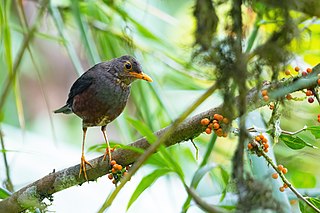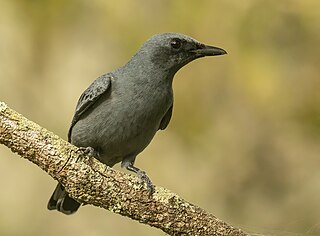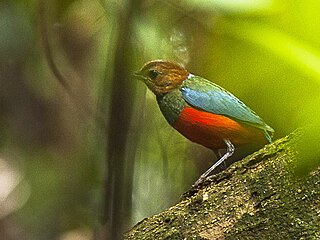
The island thrush is a common forest bird in the thrush family. Almost 50 subspecies have been described, ranging from South East Asia and Melanesia, to Samoa, exhibiting great differences in plumage. Several subspecies are threatened and three have already become extinct.

The buff-banded rail is a distinctively coloured, highly dispersive, medium-sized rail of the rail family, Rallidae. This species comprises several subspecies found throughout much of Australasia and the south-west Pacific region, including the Philippines, New Guinea, Australia, New Zealand, and numerous smaller islands, covering a range of latitudes from the tropics to the subantarctic.

The uniform swiftlet, also known as the Vanikoro swiftlet or lowland swiftlet, is a gregarious, medium-sized swiftlet with a shallowly forked tail. The colouring is dark grey-brown, darker on the upperparts with somewhat paler underparts, especially on chin and throat. This species is widespread from the Philippines through Wallacea, New Guinea and Melanesia. It forages for flying insects primarily in lowland forests and open areas. It nests in caves where it uses its sense of echolocation, rare in birds, to navigate.

The New Britain sparrowhawk is a threatened species of bird of prey. It is endemic to two Papua New Guinea islands, New Britain and New Ireland. Even in 1934 Ernst Mayr, in his survey of mountain bird life during the Whitney South Sea Expedition, found the New Britain sparrowhawk to be very rare. This species was formerly placed in the genus Accipiter.

The glossy swiftlet is a species of swift in the family Apodidae. It is found on the Indonesian island of Sulawesi and eastwards to New Guinea, the Bismarck Archipelago and the Solomon Islands.

The red-flanked lorikeet is a species of parrot in the family Psittaculidae. It is found in Mollucas, New Guinea and the Bismarck Archipelago. Its natural habitats are subtropical or tropical moist lowland forests and subtropical or tropical mangrove forests. Only the adult males have the red plumage on the head and sides.

The Bismarck hanging parrot or green-fronted hanging parrot is a small species of parrot in the family Psittaculidae. It is endemic to forest in the Bismarck Archipelago in Papua New Guinea. It is threatened by habitat loss. It is sometimes considered a subspecies of the orange-fronted hanging parrot.

The white-bellied cuckooshrike is a species of bird in the family Campephagidae. It is found in Australia, the Moluccas, New Guinea and the Solomon Islands.

The Sahul cicadabird, previously known as the common cicadabird or slender-billed cicadabird, is a species of passerine bird in the family Campephagidae. It is found in Australia, New Guinea and the Bismarck Archipelago. Its natural habitats are temperate forest and subtropical or tropical moist lowland forest. The species is placed in the reinstated genus Edolisoma by most authors. The common cicadabird was described as a "great speciator" by Mayr & Diamond (2001); and Pedersen et al. (2018) described how this species rapidly colonized and diversified across the Indo-Pacific island region and Australia in the Pleistocene.

The golden monarch is a species of passerine bird in the family Monarchidae found in New Guinea. Its natural habitats are subtropical or tropical moist lowland forests and subtropical or tropical moist montane forest. The golden monarch displays marked sexual dimorphism, the male a striking golden colour with black mask, wings and tail, the female a golden or golden-olive colour. Both bear a characteristic 'teardrop' white pattern below the eye.

The black sunbird is a species of bird in the family Nectariniidae. It is found in eastern Indonesia and New Guinea. Its natural habitats are subtropical or tropical moist lowland forest and subtropical or tropical mangrove forest.

The Philippine pitta or blue-breasted pitta, is a species of bird in the family Pittidae. It is a striking and colorful with a red belly, black throat, a brown head, a blue chest, rump and tail. It is found in Indonesia and the Philippines. Its natural habitat is tropical moist lowland forest. It is part of the Red-bellied pitta species complex.

The banded yellow robin or olive-yellow robin is a species of bird in the Australasian robin family Petroicidae that is found in New Guinea. It is the only species in the genus Gennaeodryas. Its natural habitats are subtropical or tropical moist lowland forest and subtropical or tropical moist montane forest. It is threatened by habitat loss. It has a high mortality rate due to its inability to traverse across a matrix.

The white-winged fantail or Cockerell's fantail, is a species of bird in the family Rhipiduridae. It is found in the Solomon Islands apart from the island of Malaita in the southeast of the archipelago. The white-gorgeted fantail was formerly considered as a subspecies.
The Bismarck whistler is a species of bird in the family Pachycephalidae, which is endemic to the Bismarck Archipelago north-east of New Guinea.
The Bismarck cicadabird is a species of bird in the family Campephagidae. It is endemic to islands in the Bismarck Archipelago. It was previously considered to be conspecific with the common cicadabird.

The variable goshawk is a bird of prey native to Indonesia, Papua New Guinea and the Solomon Islands. It was recently elevated to species status, and was previously lumped together with the grey goshawk. This species was formerly placed in the genus Accipiter.

The Sulawesi pitta is a species of pitta. It was considered a subspecies of the red-bellied pitta. It is endemic to Indonesia where it occurs in Sulawesi, Manterawu, and Togian Islands. Its natural habitat is subtropical or tropical moist lowland forest. It is threatened by habitat loss.
The Louisiade pitta is a species of the pitta. It was considered a subspecies of the red-bellied pitta. It is endemic to Rossel Island in the Louisiade Archipelago in Papua New Guinea. Its natural habitat is subtropical or tropical moist lowland forests. It may be threatened by habitat loss, but is currently listed by the IUCN as Data Deficient as there have been no definite records since the type specimen was collected in 1898. However an expedition to the island in 2014 revealed that local people said they still encountered it. In 2022, British tourist Michael Smith found two alive individuals with clear photograph evidence.

The Papuan pitta is a species of pitta. It was formerly considered a subspecies of the red-bellied pitta. It is found in the Aru Islands, New Guinea and the northern Cape York Peninsula. Its natural habitat is subtropical or tropical moist lowland forest. It is threatened by habitat loss.

















